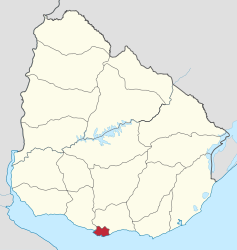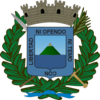Montevideo Department
| Montevideo | ||
|---|---|---|
| Symbols | ||
|
||
| Basic data | ||
| Country | Uruguay | |
| Capital | Montevideo | |
| surface | 525.5 km² | |
| Residents | 1,319,108 (2011) | |
| density | 2510 inhabitants per km² | |
| ISO 3166-2 | UY-MO | |
| Website | www.montevideo.gub.uy (Spanish) | |
| politics | ||
| Intendant | Ana Olivera | |
| Political party | Front Amplio | |
| View of Montevideo | ||
Coordinates: 34 ° 50 ′ S , 56 ° 10 ′ W
Montevideo is the smallest in area, but most populous of the nineteen departments of the South American state of Uruguay . The department consists of the city of the same name, Montevideo , which is both the capital of the state and the department, and some satellite cities such as Santiago Vázquez . It is not congruent with the Zona metropolitana de Montevideo , which also includes cities in the surrounding departments.
geography
location
The department, which covers an area of 525.5 km², is located in the south of the country on the Río de la Plata and borders on the departments of San José and Canelones . More than half of this area is taken up by rural areas, the highest point the department reaches at the 132 m high Cerro de Montevideo . In the south, the department has a 67 km long coast on the Río de la Plata.
Natural resources
Are looking at on the Departamentogebiet Carrasco Limos -Occurrence.
population
| city | Population (2004) |
|---|---|
| Montevideo | 1,269,552 |
| Pajas Blancas | 1,976 |
| Santiago Vázquez | 1,482 |
| Abayubá | 924 |
| rural population | 52.034 |
| Total | 1,325,968 |
About 40% of the population of Uruguay, over 1.3 million people, are concentrated in the Montevideo department; With a population density of 2,523 inhabitants per km², it is also the most densely populated. In the 2004 census, 456,587 households were counted; the growth rate was 0.047% and the average age was 33.8 years.
While in 2004 there were still 1,325,968 inhabitants, the number of inhabitants determined in the context of the 2011 census was 1,319,108. Of these, 613,990 were men and 705,014 were women.
history
The department was founded in January 1816 as one of the original six of the Banda Oriental ; its borders have not changed since 1835. In 1990 a process of decentralization of the department was initiated, since then the department has been administratively divided into 18 zonas or distritos . These individual zones each have a municipal center called Centro Comunal Zonal (CCZ). In addition, the local parliaments set up in 1993 and known as Juntas Locales and the neighborhood councils ( Consejos Vecinales Assesores ) established a little later are available to promote and monitor local plans .
politics
The current incumbent in the function of the Intendente des Departamentos has been Ana Olivera from Frente Amplio since her election on May 9, 2010 , who replaced her predecessor Hyara Rodríguez , who had been in office since February 26, 2010 .
Infrastructure
education
The Montevideo Department has a total of 69 secondary schools ( Liceos ), in which 143,821 students are taught by 5,808 teachers. The oldest Liceo in the department is Liceo Nº 35 "Instituto Alfredo Vásquez Acevedo", founded in 1911 . (As of December 2008)
Web links
- Intendencia Municipal de Montevideo.
- El proceso de Descentralización y Participación ciudadana in Montevideo.
- Sistema de informacion geografica Municipal
- City and department data
- Montevideo in the Enciclopedia Geografica del Uruguay (Spanish)
Individual evidence
- ↑ Ulises Rubens Grub : Atlas geografico de la República Oriental del Uruguay, Montevideo 1980, p. 35
- ↑ Censo 2004 - Población por tipo de vivienda, según localidad ( MS Excel ; 24 kB) Instituto Nacional de Estadística. February 8, 2011
- ↑ Statistical data of the 2011 census ( memento of the original from September 27, 2015 in the Internet Archive ) Info: The archive link was inserted automatically and has not yet been checked. Please check the original and archive link according to the instructions and then remove this notice. of the Instituto Nacional de Estadística de Uruguay , accessed on August 29, 2012 (XLS file; 25 kB)
- ^ "Sport and Society in Uruguay", p.17f by Bernd Schulze
- ↑ Liceos del Uruguay (Spanish) (PDF; 7.3 MB), accessed on February 29, 2012





